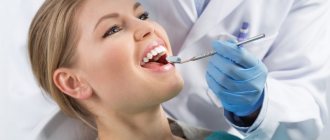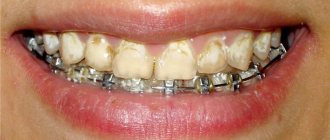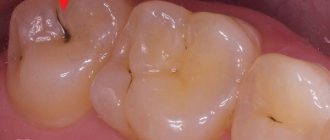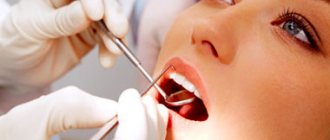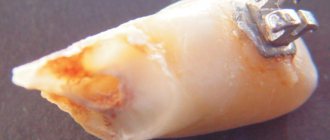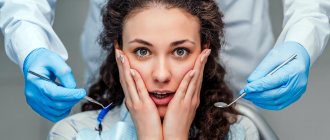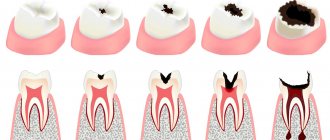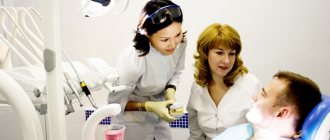Causes Types of prevention Hygiene Treatment in the stain stage How to avoid?
Caries is damage to hard dental tissues with the formation of cavity defects. First, the enamel is destroyed, then areas of dentin, pulp, periosteum and bone. It is the most common dental disease in the world and the leading cause of tooth loss. Comprehensive prevention of dental caries increases the resistance of the enamel layer to various cariogenic factors and prevents destruction of tooth structures.
Causes of the disease
The leading cause of caries is the activity of oral bacteria. The normal microflora of the mouth consists of many microorganisms. Among them there is a group of cariogenic bacteria that negatively affect the enamel. In the absence of factors that weaken the body’s defense response, the number of opportunistic microorganisms does not exceed the norm and the disease does not develop. But if there are too many bacteria, the organic acid they produce begins to gradually dissolve areas of the enamel layer. Primary prevention of caries is aimed at eliminating the causes and conditions that contribute to its occurrence.
The following factors contribute to the development of the carious process:
- disorders of mineral metabolism in the body;
- changes in the composition of saliva (increased viscosity);
- abnormal bite;
- crowded teeth;
- poor oral hygiene;
- addiction to sweet, sticky, viscous foods;
- cracks, chips of enamel;
- heredity;
- deficiency of fluorine, calcium, phosphorus in drinking water and food;
- reduced immunity.
The causes of caries are different, but the main mechanism of development is the same - lack or lack of oral hygiene. Primary prevention of dental diseases begins with regular removal of bacterial plaque, which creates a favorable environment for the proliferation of cariogenic microorganisms. This differs from secondary prevention, which consists of treating the disease and its complications.
Fluoride in our lives
Fluoride is considered an essential trace element as it plays an important role in the formation of bones and teeth. Fluoride enters the body mainly through food, is absorbed in the gastrointestinal tract, and only in small quantities comes from the air through the lungs. On the surface of the tooth, ideally, there is a balance between the processes of de- and remineralization.
When plaque appears on the tooth and food rich in sugar remains on the teeth, this balance is disrupted and demineralization predominates. First, a microscopic carious lesion forms, which eventually develops into a carious cavity. Fluoride reverses this reaction towards remineralization. Thus, minor enamel damage can be remineralized with the participation of fluoride.
Fluoride prophylaxis can be group or individual.
Group prevention includes fluoridation of water or table salt, fluoride tablets, rinses containing salt, gels, and fluoride toothpastes.
Fluoride must be supplied to the body throughout life. For people with an average tendency to caries, all fluoridation methods are effective. You should use fluoride toothpaste daily.
Children under 6 years of age should not use fluoride products because they cannot rinse their mouth thoroughly and large amounts of fluoride compounds enter the body. With regular use, the increase in caries is reduced by 25%.
How to avoid caries?
Depending on the depth of damage to hard tissues, there are 3 stages of caries - initial (spot stage), medium, deep. The rate of destruction of dental structures varies. In adults, the disease is predominantly sluggish and chronic. Children are more often diagnosed with an acute form of the disease with rapid destruction of dental structures. Inattention to the condition of teeth leads to progression of the disease. A carious lesion from the spot stage very quickly passes into the middle form, when dentin is destroyed and a visually noticeable defect is formed - a carious cavity.
How to avoid caries? Simple methods of primary prevention will help with this, most relevant when there is no visible damage to dental tissues.
Root caries and the role of fluoride prophylaxis in its prevention and treatment
Root caries is the most problematic localization of a carious lesion, which can minimize the chances of success of therapeutic treatment of a tooth and lead to complications such as fracture of the coronal part of the tooth, the rapid development of endodontic complications, etc. The tendency for the circular spread of the pathological process can significantly complicate the surgical and restorative treatment of root caries. Ultimately, it is this localization of carious lesions that most often leads to tooth loss.
Considering the above, epidemiological information that the problem of root caries is increasingly encountered in clinical practice, especially among older people, sounds especially alarming. Improving the preservation of natural teeth in the older age group also has the “other side of the coin” - a tendency to increase the incidence of root caries. The susceptibility to root caries among persons aged 75 years and older is almost 2 times higher than in the previous age group. In a systematic review by J. L. Leake. It has been shown that the expected rate of increase in root caries among the population over 50 years of age is at least 1 affected surface per year.
Definition, diagnosis and epidemiology
Root caries (or cementum caries) is a carious lesion located within or apical to the exposed enamel-cement junction (ECJ) and manifested clinically or radiologically by pronounced demineralization of hard tissues. More often, the pathological process begins from the cementum of the tooth root, although in some cases it may primarily develop in dentin. A carious lesion may appear as a spot (white or pigmented) or as a cavity defect. Most often, root caries has a supragingival localization, but due to poor oral hygiene it may be covered by inflamed hypertrophied gums. The most typical localization of root caries is in areas of the dentition with low salivary clearance (i.e., less well washed by saliva). In the frontal part of the dentition, the exposed buccal surfaces of the roots of the upper incisors are more susceptible to root caries; in the lateral group, the molars of the lower jaw are more susceptible.
Carious root damage begins with a softening of the surface. Tactile characteristics during probing are most informative for differential diagnosis between the active course and remission of root caries in comparison with assessment of the color of the carious spot. Another important clinical feature of root caries is that the pathological process is not necessarily accompanied by a progressive deepening of the cavity defect. In this regard, when classifying root caries, they are usually guided not by the depth of the cavity, but by tactile sensations during probing: hard surface, “skinny” spot, softening of tissues.
Etiology and risk factors
Currently, Streptococcus mutans is considered the main microbial pathogen associated with the development of root caries, although a significant additional role of Lactobacillus and Actinobacillus has been demonstrated. Fungal pathogens such as Candida Albicans are often detected in the tissue decay of the necrosis zone, but their role in the mechanisms of root caries has not been confirmed.
Factors that contribute to the development of root caries include xerostomia, poor oral hygiene, diets high in refined carbohydrates, medical conditions, low socioeconomic status, use of partial dentures, smoking, improper brushing techniques that contribute to the development of gum recession, as well as periodontal diseases, accompanied by gum recession and a decrease in the level of periodontal attachment. Men are more susceptible to developing root caries compared to women.
Prevention and treatment: general principles
The peculiarity of therapeutic tactics for root caries is determined, on the one hand, by the fact that surgical and restorative treatment is associated with a number of technical difficulties. On the other hand, it has been shown that root caries can stop, moving into a stable stage of remission (“arrested caries”). The above determines the importance of early diagnosis and non-invasive therapy aimed at preventing further progression of the pathological process.
The role of fluoride prophylaxis
There is extensive clinical evidence for the effectiveness of fluoride prophylaxis in preventing root caries. At the same time, the specificity of fluoride prevention of root caries is due to the difference in the critical (cariogenic) pH value for dentin and enamel, as well as the higher level of fluoride absorption by dentin compared to enamel. This determines the role of fluoride concentration, as well as the choice of fluoride carrier (neutral or acidylated gel, varnish) for effective prevention of root caries or remineralization of the initial lesion localized in the area of the tooth root.
The caries-preventive effect of fluorides in the area of root dentin is due precisely to the mechanisms of local action and is dose-dependent. Compared to regular fluoride-containing toothpaste, the use of remineralizing paste with a high fluoride content (5000 ppmF) not only prevents the formation of new carious lesions, but also promotes remineralization of dentin in the affected areas.
However, full independent implementation of individual oral hygienic care can be difficult for older patients, both due to a lack of hygienic skills and due to low motivation. Therefore, for this group of patients, professional prevention methods are of particular value, primarily the application of fluoride-containing gels and fluoride varnishes, which have an increased concentration of fluorides and provide a prolonged exposure time of the drug.
It has been demonstrated that daily applications of 1% fluoride-containing gel in trays help to stabilize carious root lesions in 20–70% of cases, depending on the depth of the carious defect. However, the disadvantage of using gels in elderly people is the need for frequent repeat visits for application, the significant duration of the procedure, the relative complexity and cost of the method.
The advantages of using fluoride-containing varnishes for the prevention and remineralizing therapy of root caries are associated with the simplicity and economy of application, the long-term retention of fluoride on the surface of the teeth and the prolonged release of fluoride ions.
Fluoride-containing varnishes have been used in dentistry for more than 50 years; their anti-caries effectiveness has been confirmed in numerous studies. The application of fluoride varnish is recommended as one of the key methods of professional prevention of caries in childhood, as well as in adults with a high degree of predisposition to caries.
A systematic Cochrane review showed that the use of fluoride varnishes provides a pronounced preventive effect, which is manifested by a decrease in the increase in caries intensity to 46–93% in different age groups in children and adolescents. In adults, the high clinical effectiveness of the use of fluoride varnishes has been confirmed for persons with active caries, with xerostomia, against the background of radiotherapy and in other categories of persons with an increased risk of developing caries. For the prevention and treatment of root caries, quarterly (every 3 months) applications of fluoride varnish are proposed, along with education in oral hygiene and recommendations for the use of toothpastes with a high fluoride content.
A study of the safety of using fluoride varnishes shows that the peak concentration of fluoride in the blood plasma (from 3.2 to 6.3 µmol/l) after treating teeth with fluoride varnishes is observed after 2 hours, followed by a rapid decrease in concentration within 2 hours. The observed fluctuations in plasma fluoride concentrations are similar to the values after brushing with fluoride toothpaste or taking a fluoride tablet (1 mg F-) and significantly lower compared to the same values after application of a fluoride-containing APF gel (from 16 to 76 μmol/L). These data indicate that, among the arsenal of professional fluoride prophylaxis methods, fluoride varnish applications are the safest, since they are not associated with the risk of receiving an acute or chronic toxic dose of fluoride.
An analysis of the international market for fluoride-containing varnishes indicates that the leading place in popularity belongs to Colgate Duraphat dental varnish. This material received FDA approval already in 1994. Of the fluoride varnishes on the market, Colgate Duraphat has the highest concentration of fluoride (22,600 ppm F–) in the form of sodium fluoride. From a practical point of view, these products are distinguished from existing analogues on the market by the following advantages of use: the application does not require professional hygienic teeth cleaning: regular brushing with a toothbrush or wiping the surface of the teeth with a swab is sufficient. An important advantage of Colgate Duraphat is its ability to cure in humid environments and adapt well even to wet surfaces. Very useful from a practical point of view is the property of this varnish to change color: from yellowish upon application, which allows visual control of the distribution of the varnish, to colorless upon curing. The recommended consumption of varnish for complete treatment of the dentition depends on the age of the patient: for children - 0.25–0.4 ml, for adults - up to 0.75 ml.
A number of controlled randomized clinical studies have shown that quarterly single treatment of exposed tooth roots with Colgate Duraphat dental varnish provides a pronounced (more than 50%) preventive effect, preventing the development of root caries, and also contributes to the stabilization and remineralization of active foci of root caries in more than 90% of cases .
Author:
A. M. Solovyova, Chief Advisor to the Main Medical Directorate of the UDP of the Russian Federation, Head. Department of Dentistry UMTS UDP RF, Professor St. Petersburg MAPO
Types of prevention
Preventive measures are divided into primary and secondary. Primary prevention of caries is measures taken to prevent the disease, eliminate all provoking factors and causes of its development. It can be endogenous (general) and exogenous (local). The goal of the secondary set of preventive measures is to diagnose the disease at an early stage and prevent relapse.
Exogenous methods
Exogenous prevention of caries development includes methods that increase the resistance of the enamel layer to various cariogenic factors:
- Thorough
oral hygiene - Fluoridation
- the use of pastes, gels, solutions containing fluorine, calcium, phosphorus. Applications, physiotherapeutic procedures with remineralizing, fluoride compounds. Toothpaste for the prevention of caries, in addition to hygienic cleaning, provides additional mineralization of the enamel, increasing its protection, reducing the risk of disease. - Regular prof.
examinations - even in the absence of visible signs of carious lesions, you need to undergo a dental examination twice a year. This will help detect the problem at an early stage and quickly eliminate it without resorting to complex treatment or drastic measures. - Professional hygiene
– removal of dental plaque (plaque, stone) in a dental office. - Sealing fissures
with polymer compounds.
Molars and premolars of both jaws are more susceptible to carious lesions, with the lesion predominantly localized on the chewing surface (in fissures, blind foramina, folds). Obturation (sealing) of fissures and other anatomical recesses of the tooth with adhesive materials creates a physical barrier that prevents the penetration of pathogenic microorganisms and organic acids that destroy dental structures into the retention areas of the enamel. The method is aimed at preventing caries of temporary and permanent teeth. The procedure is painless, the effect lasts 3-5 years
.
Endogenous methods
Endogenous prevention of caries in adults can be medicinal (medicinal) and non-medicinal:
- Non-drug measures
involve dietary correction and a healthy lifestyle. Dental health is harmed by smoking, constant consumption of sweets, baked goods, and alcohol. It is recommended to give up bad habits and replace sweets and simple carbohydrates with berries and fruits. The diet should be balanced in the content of proteins, fats, carbohydrates, vitamins, essential minerals, and trace elements. - Drug prevention
includes taking fluoride-containing drugs, vitamin complexes, and nutritional supplements in age-specific dosages. The dentist selects medications for the prevention of caries individually, based on the condition of the teeth and general health.
Comprehensive prevention of dental caries includes a balanced diet, careful hygiene, and regular dental examinations. Even if a person brushes his teeth diligently, but abuses smoking or cannot go a day without sweets, he creates favorable conditions for the proliferation of cariogenic bacteria. Dental health needs to be taken care of as a whole. Can tooth decay be cured with toothpaste? No! But it is necessary to use it to prevent disease.
Oral hygiene
The most common cause of tooth decay is poor oral hygiene. Prevention and treatment of dental caries begins with the removal of soft plaque, because it is a breeding ground for bacteria. Recommendations that, if followed, significantly reduce the risk of enamel destruction:
- brush your teeth at least twice a day and do it correctly: the movements should be sweeping - from the gums to the edges of the crowns of the teeth. The cleaning process should take at least 3 minutes;
- when brushing, pay attention not only to the teeth, but also to the tongue, gums, and the inner surface of the cheeks;
- choose the right toothbrush: soft bristles are suitable for people suffering from inflammatory gum diseases and periodontal disease. Medium-hard bristles are optimal for most people. A hard brush is indicated for increased plaque formation, as well as a special love for tea and tobacco; such a brush can only be used if the gums and strong enamel are in good health;
- Be sure to use dental floss. Floss will help cope with food debris in the interdental spaces;
- Use mouth rinses (without ethanol) after meals, throughout the day.
When choosing a toothpaste, it is worth considering several conditions: large abrasive particles in the composition are contraindicated for people with thinned, damaged enamel, cracks. Even with good oral health, you should not get carried away with abrasive pastes. Pastes with a high fluoride content may be useful in prevention, but their use is only allowed for adults.
Professional hygiene
Modern methods of preventing dental caries involve in-office hygienic cleaning twice a year. Professional hygiene is aimed at removing bacterial plaque and mineralized formations (plaques, stones) from the supragingival and subgingival parts of the tooth. Hygienic cleaning includes the following steps:
- Removal of hard and soft deposits using the AIR-FLOW method or ultrasonic scaler.
- Polishing the surface of the teeth with an abrasive paste.
- Protection of enamel with fluorine varnish.
Hygienic procedures are painless and carried out quickly. Another plus is that the dentist gets the opportunity to accurately assess the condition of the oral cavity and detect pathology at the initial stage. Each stage can be carried out as an independent procedure. But it is a complete hygiene complex that will ensure effective prevention of diseases of the teeth and gums.
Fluoride-containing products and “DENTiK LUX”
In clinics, varnishes, gels, and foams are used for the purpose of fluoridation, prevention of tooth decay, reduction of dentinal sensitivity, and reduction of plaque buildup.
In our clinic we use fluoride-containing foam SULTAN, applied to standard mouth guards. This product is ideal for patients of all ages, even those with cosmetic restoration, reduced salivation and intolerance to acid fluoride. To achieve the desired result, four procedures per year are required.
We also use FLUORPROTECTOR varnish. Many years of clinical experience with this varnish confirm its effectiveness. The varnish is applied to surfaces with an increased risk of developing caries (fissures, contact surfaces of teeth).
In order to prolong the stay of the varnish on the surface of the teeth on the day of application, do not brush your teeth before going to bed.
Treatment methods for caries in the spot stage
The appearance of a matte white smooth spot on the enamel is the first sign of a carious process. Such a stain means that the enamel in this place is demineralized and is more susceptible to destruction. Qualified therapy includes the following:
- professional hygiene;
- remineralization therapy, which uses drugs for the prevention of caries containing fluoride and calcium;
- regular dental examinations.
One of the latest innovations in drill-free treatment is Icon technology. After pre-treatment, a special infiltrate is applied to the affected area of enamel. The material penetrates deeply into the enamel structure, filling the defect. Excess material is removed, and the treated area is polymerized with a UV lamp. The defect is sealed, the carious process stops.
If the stain has reached the stage of pigmentation and a cavity defect has appeared on the enamel, then the affected tooth will require preparation followed by filling. The dentist selects the treatment method according to the clinical picture.
Prevention means
General means of caries prevention, such as toothpastes containing fluoride and calcium, and dental floss with fluoride, can be used with virtually no restrictions. Even fluorosis is not always a contraindication to the use of such drugs. If the patient has underlying oral health conditions, the dentist may recommend specific home preventive measures. For example, for chronic inflammatory diseases of the mucous membranes and/or gums, a mouthwash with antibacterial components can be used.
ANTENATAL PREVENTION
It is mistakenly believed that children need to take care of their oral cavity from about the age of three. In fact, the prerequisites for the occurrence of dental diseases often arise even before the baby is born. The rudiments of baby teeth begin to form already from the sixth week of pregnancy, and the rudiments of permanent teeth - from the twentieth. If during this period the fetus does not receive calcium and other microelements, the mineralization of dental tissues slows down, and the baby may subsequently have serious problems not only with milk teeth, but also with permanent teeth.
The goal of antenatal prevention is to prevent the child from developing dental diseases associated with problems in the prenatal period. To provide the fetus with the microelements it needs, a special nutritional plan is developed for the expectant mother.
In addition, if a woman suffers from periodontal disease during pregnancy, the newborn baby is at risk. In contact with the mother, the child will certainly become infected with pathogenic bacteria, and the erupted milk teeth will be affected by caries. Therefore, all actions to sanitize the oral cavity of the expectant mother should be carried out even before birth. The use of painkillers is possible from approximately 16 weeks of pregnancy.
WHY IS IT IMPORTANT TO VISIT A DENTIST REGULARLY?
In order to prevent the occurrence of caries, hygiene procedures alone are not always enough. If a patient has an incorrect bite or the teeth are too close together, orthodontic treatment may be necessary.
According to the accepted classification, according to the depth of damage, caries is divided into initial, superficial, medium and deep. This is an insidious disease, and it is quite difficult to independently determine it at the initial stage. The first carious spots almost do not differ in color from tooth enamel, and if you do not pay attention to them, the disease can very quickly go through all stages, completely destroy the tooth and affect neighboring ones.
Early diagnosis of caries allows for its treatment using the most gentle methods. It is very important to prevent the development of the disease and the occurrence of complications, in particular, periodontal inflammation, when no home remedies or rinses can help. Therefore, it is necessary to visit the dentist at least once every six months for a preventive examination and exogenous procedures.
The DentaLux-M dental clinic has developed an effective system for the prevention of dental diseases. Experienced doctors use the most modern equipment and new technologies.
By visiting the clinic once every six months and following your dentist’s recommendations, you will maintain a radiant smile for a long time.
DRUG ENDOGENOUS PREVENTION
One of the reasons for the demineralization of dental tissues and the appearance of caries is living in an area where the soil and water are poor in fluoride. Vegetables and fruits grown in such conditions simply cannot contain the required amount of this microelement. As for calcium, the situation here is not the best: not everyone likes dairy products, and for many they are simply contraindicated. Therefore, a regular balanced diet often does not provide the body with all the necessary substances, and dentists recommend that patients take nutritional supplements with calcium, fluoride, vitamins B and D. Water fluoridation gives good results. To increase immunity after illnesses, immunomodulator drugs are used.
However, you should only take fluoride supplements and other medications as directed by your doctor. Excess fluoride in the body leads to a serious disease - fluorosis (the appearance of stains on tooth enamel and its subsequent destruction).
